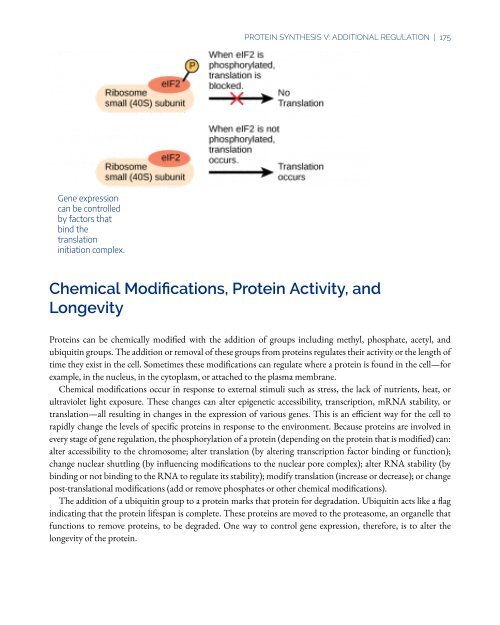An Interactive Introduction to Organismal and Molecular Biology, 2021
An Interactive Introduction to Organismal and Molecular Biology, 2021
An Interactive Introduction to Organismal and Molecular Biology, 2021
You also want an ePaper? Increase the reach of your titles
YUMPU automatically turns print PDFs into web optimized ePapers that Google loves.
PROTEIN SYNTHESIS V: ADDITIONAL REGULATION | 175<br />
Gene expression<br />
can be controlled<br />
by fac<strong>to</strong>rs that<br />
bind the<br />
translation<br />
initiation complex.<br />
Chemical Modifications, Protein Activity, <strong>and</strong><br />
Longevity<br />
Proteins can be chemically modified with the addition of groups including methyl, phosphate, acetyl, <strong>and</strong><br />
ubiquitin groups. The addition or removal of these groups from proteins regulates their activity or the length of<br />
time they exist in the cell. Sometimes these modifications can regulate where a protein is found in the cell—for<br />
example, in the nucleus, in the cy<strong>to</strong>plasm, or attached <strong>to</strong> the plasma membrane.<br />
Chemical modifications occur in response <strong>to</strong> external stimuli such as stress, the lack of nutrients, heat, or<br />
ultraviolet light exposure. These changes can alter epigenetic accessibility, transcription, mRNA stability, or<br />
translation—all resulting in changes in the expression of various genes. This is an efficient way for the cell <strong>to</strong><br />
rapidly change the levels of specific proteins in response <strong>to</strong> the environment. Because proteins are involved in<br />
every stage of gene regulation, the phosphorylation of a protein (depending on the protein that is modified) can:<br />
alter accessibility <strong>to</strong> the chromosome; alter translation (by altering transcription fac<strong>to</strong>r binding or function);<br />
change nuclear shuttling (by influencing modifications <strong>to</strong> the nuclear pore complex); alter RNA stability (by<br />
binding or not binding <strong>to</strong> the RNA <strong>to</strong> regulate its stability); modify translation (increase or decrease); or change<br />
post-translational modifications (add or remove phosphates or other chemical modifications).<br />
The addition of a ubiquitin group <strong>to</strong> a protein marks that protein for degradation. Ubiquitin acts like a flag<br />
indicating that the protein lifespan is complete. These proteins are moved <strong>to</strong> the proteasome, an organelle that<br />
functions <strong>to</strong> remove proteins, <strong>to</strong> be degraded. One way <strong>to</strong> control gene expression, therefore, is <strong>to</strong> alter the<br />
longevity of the protein.


















